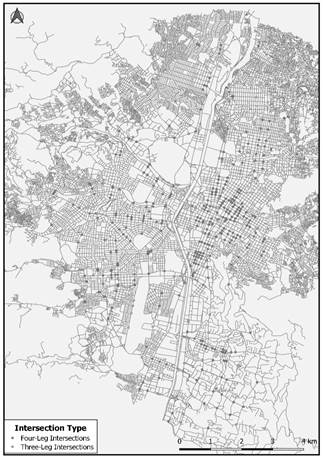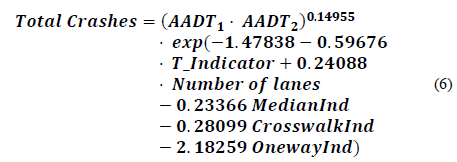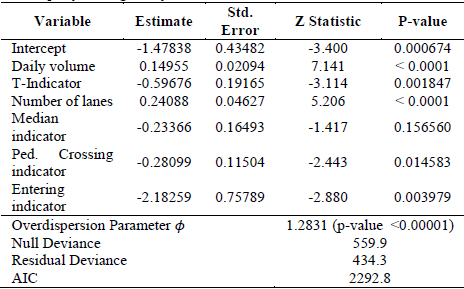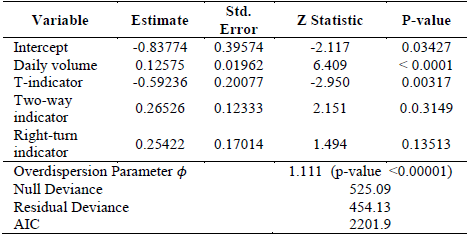1. Introduction
A rapid increase in the number of motorized vehicles has been observed in developing countries. This increase has caused undesirable effects such as congestion, pollution, and road crashes; the latter has caused great concern and multiple solutions have been proposed to decrease the frequency and severity of collisions.
Accidents negatively impact society, the economy, and people’s quality of life. Every year, 1.23 million people die and more than 50 million are injured in traffic crashes; trends suggest that these numbers may escalate over the next 20 years if no preventive action is taken [1].
According to the World Health Organization (WHO), the number of fatalities per 100,000 people is inversely related to a country’s income. In Latin America and the Caribbean, collisions cause approximately 100,000 deaths per year; with 7% of these occurring in Colombia [2]. This figure is markedly high, considering the small size of the region, which is made up of only 46 countries.
The National Institute of Forensic Sciences reported 6,295 fatalities in Colombia in 2016 related to ground transportation. The crash rates continue to grow and this year, the highest numbers for the 21st century have been recorded [3]. The phenomenon is concentrated in urban areas, with 57% of fatal crashes in 2016. Colombia’s death rate from accidents stands at 14.93 deaths per 100,000 people, and the rate of injury is around 90 injured per 100,000 people [1]. Traffic accidents are the eighth most common cause of death in Colombia [4].
In 2016, Antioquia was reported to be the department with the largest number of crashes, of which 14.09% caused fatalities and 11.22% caused injuries. There were 275 fatal crashes and 2,725 injured on Medellín’s roads, making it the third most dangerous city in Colombia in terms of road accidents [3].
Bocarejo found that the economic loss of traffic crashes between 2008 and 2010 accounted for 1% of Colombia’s Gross Domestic Product (GDP) [5], Bhalla estimated that this was equivalent to 2.3% of the GDP in 2010 [6].
The Decade of Action for Road Safety (2011-2020) is a ten-year program promoted by the UN, and in 2010 it produced the National Road Safety Plan (2013-2021). The plan includes the creation of road safety policies.
Achieving a decrease in crash frequency and severity should be the main concern. It is necessary to compile guidelines for highway design, along with a road safety evaluation tool to quantify the possible externalities. This study aims to use predictive methods for crash frequency to quantify the risk.
2. Literature review
Statistical models that predict crash frequency and severity have not been commonly used in developing countries. For instance, there are two studies that estimated crash severity using the Medellin database, one by Mesa-Arango et al. that used a multinomial logit model (MNL) and one by Lizarazo and Valencia that used a spatial macroscopic approach for studying pedestrian-car collisions [7,8].
The Highway Safety Manual (HSM) is a guide that has been well studied and is focused on applicability and the creation of self-build tools that aid the safety management process, including Safety Performance Functions (SPF) [9]. The HSM includes predictive models of crash frequency along road segments and at intersections that aim to improve the decision-making process. These methods have been included in the Interactive Highway Safety Design Model (IHSDM) as the Crash Prediction Model (CPM).
Marchionna, Perco, and Falconetti evaluated the application of CPM on two-lane roads in Italy, and found that it was challenging to apply the tool to the Italian conditions and recommended that a context-specific SPF be created to improve its reliability for estimating crashes [10]. In another study, Fei Xie calibrated a predictive model with local factors for the HSM on rural roads in Oregon, USA [11].
Tegge, Jo, and Ouyang explained how to develop SPF that include geometric and traffic volume data [12]. Williamson and Zhou developed calibration parameters for the CPM on two-lane roads in Illinois [13]. Mehta and Lou developed SPF on a rural road in Alabama and also applied predictive methods from the HSM to develop SPF on two-lane and four-lane rural roads [14].
Tarko et al. compared the methods proposed by the HSM with their own methods in Indiana. The calibration of the basic SPF produced an insufficient number of roads and therefore their reliability was decreased. The study shows that both the author’s methods for obtaining the SPF and those proposed by the HSM yield equivalent results, and so it can be inferred that, to create a reliable tool, the calibration of the HSM method is not necessarily the best approach [15].
Mannering and Bhat produced guidelines for the statistical analyses used in the creation of road safety and crash frequency models. They found that Poisson and Negative Binomial regressions are two of the most common approaches used to calibrate SPF [16].
Jovanis and Chang noted that the distribution of crashes is biased towards the right side, and the normal approximation for a linear regression is not suitable. Instead of a multivariate linear regression, the Poisson approach was used to estimate the crashes [17]. Kraus et al. explored the relationship between the type of crashes and the geometric characteristics, time of day, and traffic volume in an urban environment, applying a non-linear predictive model and using a Poisson regression [18]. Khan et al. used a Poisson regression to analyze the relationship between the severity of crashes and traffic volume, segment length, and miles traveled [19].
Lyon et al. created SPF for signalized intersections to evaluate left-turn priority treatment in Toronto, Canada. Intersections were classified in terms of the number of legs, functional classification of roads, traffic volume, pedestrian volume, and presence of left/right turn protection. Data was analyzed using the empirical Bayes approach [20].
In Argentina, Garcia and Altamira calibrated the CPM module in San Juan. They presented a calibration methodology that targets a local calibration factor to adjust the SPF on two-lane rural roads. They were successful in calibrating the tool and results were better than the estimated values calculated originally [21]. In Brazil, Barbosa et al. developed SPF models for urban intersections, of the predictors used it is important to highlight the annual average daily traffic (AADT), number of carriageways, number of access and presence of median [22].
3. Data
Crash data were provided by Secretaria de Movilidad de Medellin (SMM) for the 2009-2016 period. These data are derived from police and traffic enforcement agents’ reports (IPAT in Spanish). The database was preprocessed to avoid noise filtering of signalized intersections, then a data cleaning was performed, and finally, crashes at each intersection were assigned according to their severity level: property damage only (PDO), and fatal and injury crashes (FI). Variables were coded to facilitate statistical processing and improve computational time.
The complete set of records registers 357,696 crashes, of which 226,211 are FI; the number of crashes at intersections represents 14% of the total. This study focused on signalized urban intersections with 3 and 4 legs, which gave us a total of 9,974 crashes to analyze, 26 of them fatal, 3,990 caused injuries, and 5,958 caused PDO.
Geometric features were provided by SMM. This allowed us to locate, analyze and subdivide the intersections. It facilitated the inclusion of new data such as the geographic location, geometric conditions, intersection layout, surrounding lighting, transit facilities, and others. Centro de Información y Operación de Semáforos (CIOS) provided data on signals which helped us identify the target locations. Additional data was collected using MapGIS and Google Earth.
The signal network is made up of 681 locations, the intersections of interest account for 88 T-junctions and 359 four-leg intersections. Fig. 1 shows the location of the intersections analyzed.

Source: Elaborated by The Authors based on “Amoblamiento intersecciones semaforizadas ciudad de Medellín” CIOS and “Red vial de Medellín” SMM.
Figure 1 Location of signalized intersections in Medellín, Colombia.
Then, we proceeded to develop a complete characterization of the population based on the information extracted from the road network using MapGIS (SMM’s Geographic Information System). The variables included are: number of carriageways and number of lanes per access, presence of turning maneuvers, flow direction (one-way entering, exiting, or two-way), type and width of median, presence of crosswalk, and the angle at which the two roads cross at the intersection.
Traffic volume data was facilitated by SMM. The data have been collected continuously since 2012 using traffic cameras that summarize the conditions every hour. It was complemented with 7 other databases with multiple aggregation levels of traffic volume.
The exposure variable used was AADT of the major and minor approaches at each intersection. However, to determine its value we had to perform assumptions, analogies, interpolation, and expansion of factors. The AADT for each year was estimated, assuming an increase in motorized vehicles in the metropolitan region of Valle de Aburra. Intersections without information were georeferenced using ArcMap and Krigging interpolation was applied [23]
4. Methodology
The data analysis was performed using a negative binomial (NB) model. This type of model is based on the Poisson distribution with the inclusion of an error term that allows over-dispersion. Poisson is the most popular distribution when count data is modeled. It is a useful analysis tool, which - according to Poch and Mannering - is the natural choice for modeling crashes [24]. However, if its limitations are not fully understood, it can be applied inappropriately. According to Lord and Mannering, three limitations are included for the application of Poisson distribution. The first is the failure to recognize that the data are truncated. The second is the failure to recognize that the data contain a preponderance of zeros. The third is the failure to identify when the mean is different from the variance [25]. In general, in data where the mean and the variance are not approximately equal, the variances of the estimated Poisson model coefficients tend to be overestimated and the coefficients themselves are biased. Negative binomial distribution is applied in this study by considering the inherent over-dispersion of crash data. The negative binomial can be represented by the expressions:
Where P(y i ) is the probability that the roadway i will have y i number of crashes during the analysis period, λ i is called the Poisson parameter, and ε i is the gamma distributed error term with a mean equal to 1 and a variance equal to α. The NB model considers the nature of the response variables (positive integers), and the ability to accommodate over-dispersion within the data which is commonly observed in data with diverse locations. Among its limitations, the NB model has been proven to not perform well for under-dispersed data. Other issues are related to the inability to estimate parameters with small sample sizes [25]. These two limitations did not influence our analysis since the data has been proven to be over-dispersed and the sample size is sufficient.
To interpret the estimated coefficients, it is necessary to separate the variables in terms of their type. Binary variables produce a coefficient that represents the expected difference in log count between two groups. In the case of continuous variables, the coefficient represents a one-unit increase effect of the predictor variable, which is the change in the log count of crashes.
In order to assess the goodness of fit of the model, a Likelihood Ratio Test was calculated. It can be represented as follows
Where L R is the likelihood function value for the reduced model, L U is the likelihood for the unrestricted model, and the total value is a distributed Chi-square with degrees of freedom equaling the difference in degrees of freedom between the two models under the null hypothesis of trueness of the reduced model.
The statistical analysis was carried out using the GLM.NB function in R to fit a NB generalized linear model.
5. Results and discussion
The estimation of the SPF for signalized intersections in Medellín was assessed separately for crashes that caused Property Damage Only (PDO) and Fatality and Injury (FI). The estimation of the SPF was implemented for the 5-year period 2012-2016 in which crashes took place. A total of 447 intersections were included in the analysis. The exposure for SPF at the signalized intersections was represented by the product of the AADTs of the major and minor approaches. Descriptive statistics of the variables included in these two categories of SPFs are shown in Table 1.
Table 1 Descriptive statistics of SPF´s variables.
| Variable | N | Mean | Std Dev | Minimum | Maximum |
|---|---|---|---|---|---|
| PDO Crashes | 447 | 7.503 | 8.316 | 0.0 | 55.0 |
| FI Crashes | 447 | 5.740 | 6.178 | 0.0 | 38.0 |
| AADT Major Approach | 447 | 28565.0 | 19763.0 | 0.0 | 101266.0 |
| AADT Minor Approach | 447 | 26612.0 | 15578.0 | 0.0 | 75740.0 |
| T Intersection | 447 | 0.197 | - | 0.0 | 1.0 |
| Percentage Median | 447 | 0.273 | - | 0.0 | 1.0 |
| Percentage Crosswalk | 447 | 0.709 | - | 0.0 | 1.0 |
| Percentage One-way | 447 | 0.067 | - | 0.0 | 1.0 |
| Percentage Two-way | 447 | 0.628 | - | 0.0 | 1.0 |
| Percentage Right-turn Lane | 447 | 0.554 | 0.0 | 1.0 |
Source: The Authors.
The estimated safety performance functions are characterized using the expressions:
Property damage only
Fatality and Injury
The results from the negative binomial regression (NB) are presented in Tables 2 and 3. In order to examine exposure, a list of parameters is presented including variable name, estimated coefficient, standard error, Z statistic, and P-value which corresponds to the area under the curve for Z larger than 1.645 (95% confidence). Additionally, we have also included the goodness of fit measures: overdispersion parameter, null and residual deviances, and the Akaike Information Criterion (AIC).
5.1. Discussion
The two model estimations produced over-dispersion parameters larger and more significant than 1, indicating that the negative binomial regression was an adequate approach to take instead of the Poisson regression. Also, in both cases, the exposure had a positive impact on the number of crashes which is an intuitive finding. The separate influence of the volumes was also considered with a non-significant finding in the case of the AADT for the minor approach.
In terms of property damage only crashes, the T-indicator, Median indicator, the presence of crosswalk, and one-way approaches had negative effects on the number of crashes. In other words, they were found to reduce the crash frequency. The one-way indicator had the largest coefficient, indicating a strong effect on safety. This finding is a result of lower conflicting volumes of traffic when a driver faces a decision at these signalized intersections in the green-yellow transition. The T-indicator and the presence of crosswalks were found to impact positively on road safety. On the other hand, a one-unit increase in the number of lanes was found to have an increase of 1.272 in the number of PDO crashes, due to the increased exposure at these locations.
When analyzing the Safety Performance functions of crashes with fatalities and injuries, they were found to be affected by exposure, T-indicator, Two-way indicator, and right-turn indicator. The presence of hard right-turn maneuvers causes more conflict with pedestrians, increasing the likelihood of these road users being injured or killed by motorized vehicles. In terms of the T-indicator, the coefficient was found to reduce the crash count by a factor of 0.553. The geometry of T-Intersections is simpler for drivers to handle as well as reducing approaching speeds leading to less severe crashes. Two-way roads were found to increase the crash count by 1.30.
5.2. Conclusion
The primary objective of this paper was to estimate safety performance functions which were applied to signalized intersections in Medellín, Colombia. A 5-year period of analysis from 2012-2016 was used for the estimation. Two safety performance functions were estimated for each type of crash: those that caused PDO and those that caused fatalities and injuries. A Negative Binomial regression was applied considering the characteristics of crash count data (positive integers) and the inherent overdispersion, tested with the ϕ parameter which is significantly different from zero. All the factors included in the safety performance functions were significant and used a 95% confidence interval. The log-likelihood ratio test also confirms that the one that includes the additional covariates is the better model.
The results of the estimated safety performance functions are in line with the findings of related studies. T-Intersections tend to be less crash-prone due to their simpler geometry and the lower speeds at which vehicles approach them in preparation for turning maneuvers. The T-Indicator reduces the number of crashes not only with fatalities and injuries but also for lower severity crashes causing PDO. According to the model estimates, one-way approaches are safer than two-way approaches because of the lower number of conflicting maneuvers at these intersections. Finally, an interesting relationship between legal right-turns and crashes causing FI was found. Based on the results, intersections with legal right-turns, crashes that cause fatality and injury are more likely, as they create conflicts with pedestrians that tend to be more serious. Special attention at these locations and enforcement of pedestrian priority should be evaluated in order to reduce the number of serious encounters.
The study provided interesting results for the case of Medellín. Future work must be directed towards increasing the number of covariates and evaluate the influence of steepness, deflection angles, and signal-specific technologies implemented in the city. In addition, this study must not only focus on signalized intersections but should be expanded to road segments as well as non-signalized intersections to better identify the road features that require attention to reduce excessive crash risk. To this end, safety performance function is an important component as it permits the identification of potential safety problems on roads, and so safety audits can be better targeted at these locations. In general, they significantly contribute to the achievement of the most important goal of a safety management system, which is to reduce the number and severity of traffic accidents by ensuring that all opportunities to improve highway safety are identified, considered, implemented, and evaluated.























